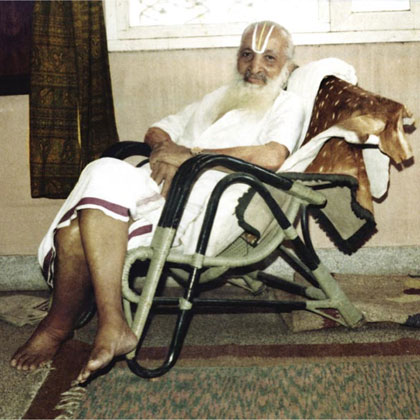by Srivatsa Ramaswami
Previously published in NAMARUPA magazine Issue (No. 6)

Sri Krishnamacharya during Class at his residence in RK Puram. Photograph by Dr. Radhakrishnan.
 CLICK TO VIEW ARTICLE (right-click to download to your own hard drive)
CLICK TO VIEW ARTICLE (right-click to download to your own hard drive)
If one were to search for the origin of what is being taught in one of today’s Western yoga studios, in most cases that path would lead to the gentleman pictured above, Sri Tirumalai Krishnamacharya. Sri Krishnamacharya, (1888-1989), taught many of the key figures in modern-day yoga, including B.K.S. Iyengar (founder of Iyengar yoga), Pattabhi Jois (the founder of Ashtanga yoga), the late Indra Devi, T.K.V. Desikachar (his son), as well as the article’s author Srivatsa Ramaswami.
When a practice belonging to the distant past is handed down and disseminated globally, crossing national and cultural barriers, one would expect to find both revision and mutation. Sometimes the degree of change can be so significant that the original propose is entirely lost. The Bhagavad-gita speaks of the uncertainty of successions.
evam parampara-praptam
imam rajarsayo viduh
sa kaleneha mahata
yogo nastah parantapaThis knowledge, known to the sage-kings, was thus gained through disciplic
succession. But in course of time the succession was interrupted, and the
link broken, Arjuna.
(Bhagavad-gita 4.2)
This thorough account takes us back in time and provides a view of yoga, beyond the superficial, as the powerfully transformational practice it was designed to be. I found the importance Sri Krsnamacharya placed on the devotional dimension within the practice of Ashtanga Yoga particularly interesting.
“Mantra yoga was a very important and integral part of Sri Krishnamacarya’s yoga. Chanting, or mantra parayana, especially of Vedic and other Puranic mantras, is practiced by hundreds of thousands of Bhakti Yogis. When Sanskrit mantra portions are recited with an understanding of their meaning, the mind achieves an excellent one-pointedness, called ekagrata, an important goal of Raja Yoga. Mantra japa, or repetition of the same short mantra such as the Gayatri or Pranava, the Siva or Narayana mantras, over and over again, helps reinforce devotional fervor and the ekagrata in the yogi. Mantra yoga and Bhakti yoga were very important ingredients in Krishnamacharya’s yoga; every yoga school would do well to add this dimension to the yogic topics they teach.”
“Sri Krishnamacharya would point out that, in Kali Yuga the main or the only means of spiritual salvation is surrender to the Lord, or Isvarapranidhana. He remarked the Isvarapranidhana is mentioned in all three levels of yoga, viz, Nirodha Yoga of the first chapter; and Kriya Yoga and Ashtanga Yoga of the second and third chapters. Surrender to the Lord, or the appropriate Isvarapanidhana (worship of the Lord) such as puja in Kriya Yoga, doing Ashtanga Yoga with a sense of total surrender to the Lord, or constant meditation on Isvara with a sense of devotion for the highest level—each forms a complete Isvarapranidana practice of yoga.”
To read the article follow the link above.
Kaustubha das
Comments
One response to “My Studies with Sri Krishnamacharya”
Thanks for a very great and informative article. One can really learn a lot from it.